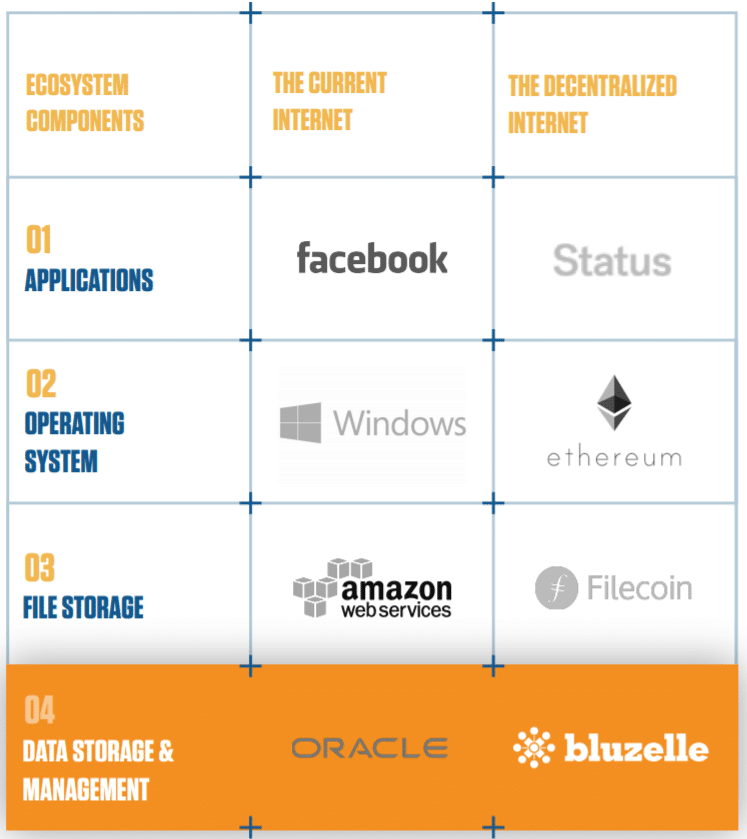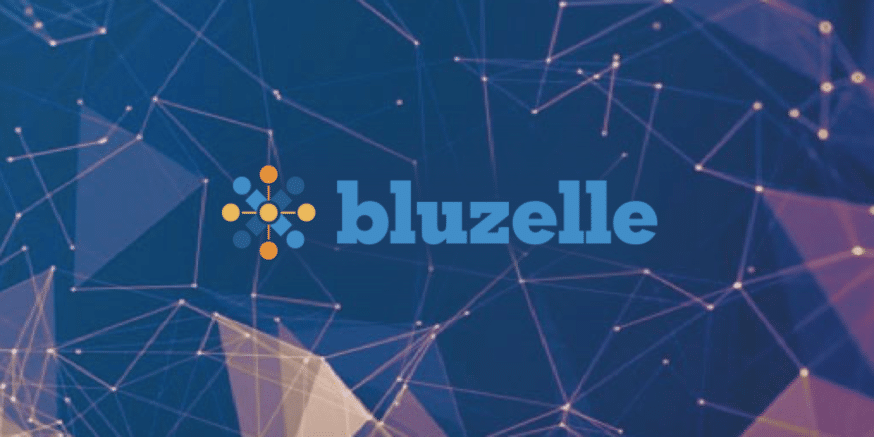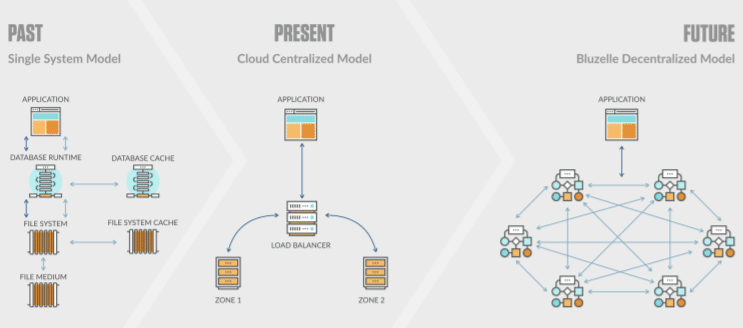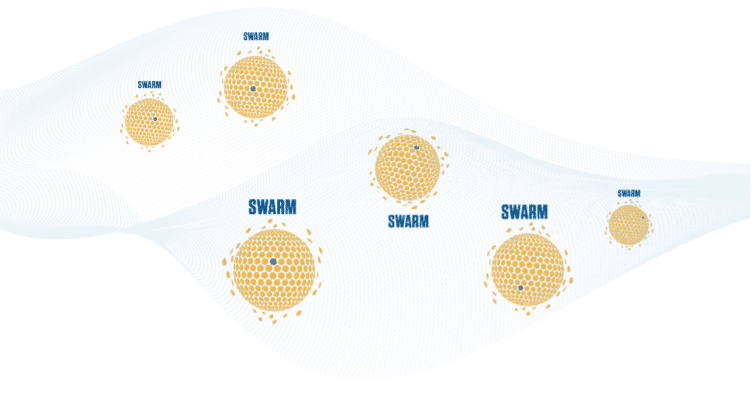What is Bluzelle?
Bluzelle wants to set a new standard for data storage and management. As blockchain is laying the brickwork for a new online, decentralized infrastructure, centralized technology won’t be sufficient enough to support this new-age experience. At least Bluzelle thinks so, and its team is doing its part to help build towards this future.
They envision that Bluzelle’s decentralized database will set a new standard for the new internet. With Bluzelle, developers and consumers can store data for their applications on its distributed network, offering a more flexible and secure model than current services. Although its target is data storage, its actually not competing with Siacoin or Filecoin, though it’s easy to think so at first glance. In theory, Bluzelle would work alongside programs like Sia, Substratum, iExec, and Golem to create the next generation internet.
How Does Bluzelle Work?
At its core, Bluzelle’s ecosystem connects consumers wishing to rent out database space to providers with additional computing resources to offer this storage. Using this data storage, DApp and application developers alike can optimize their products by accessing reliable data when necessary and storing their data on a secure platform. Providers can, in turn, earn BLZ and BNT (the two tokens on Bluzelle’s network) in compensation for providing this storage.
The structure of the network, as well as its functionality, is actually quite simple. Basically, it consists of swarms (the network nodes), a rating and governance system to manage these swarms, and a bi-token payment system.
Swarms
Like traditional blockchain nodes, Bluzelle’s swarm is the backbone of the entire platform. The swarm protocol is a network of nodes that are responsible for storing data. The singleton metaswarm is an identifier used to denote the entire swarm framework, or as the project’s whitepaper explains, it “is a symbolic grouping of all swarms.”
The virtualized metaswarm, on the other hand, is a colony of leaf swarms, the individual swarms that make up the collective virtualized body. Each leaf swarm stores a piece of data shared with the virtualized metaswarm. Whenever a consumer provides data to the network, that data is split up and stored in pieces (shards) between each leaf swarm. Sharding ensures that data is both replicated and protected so that if one node goes down in the swarm at large, the data will not be lost. When a consumer wishes to retrieve his/her data, s/he provides the private key that corresponds to that data’s value hash and the network returns the data. Since all information on Bluzelle is encrypted, no one–not even the swarms–can access data without its private key.
One last important note. Unlike traditional blockchain, not every swarm holds a copy of every piece of data on the network. Instead, they reach consensus on a localized level wherein each virtualized swarm is responsible for its own consensus and data. For instance, if Molly and Steve both commit data to the network, Molly’s might be stored on swarms 1,2, and 3 on virtualized swarm A, while Steve’s might be stored on swarms 4, 5, and 6 on virtualized swarm B. Thus, only the swarms in virtualized swarm A would be responsible for reaching a consensus for Molly’s data, and the same goes for swarms in virtualized swarm B for Steve. This ensures that the network can scale properly to ensure that data can be processed and delivered more efficiently.
Karma and Governance
In order to keep bad actors in check, Bluzelle features a Karma Index for all of its node operators. If an operator behaves poorly for whatever reason, his/her Karma Index will lower and reflect this behavior. Those with lower Karma will receive penalties, restrictions, or fewer responsibilities, and since individuals are allowed to run more than one node, their Karma applies to every node they run.
Node operators with high Karma (in the top 5% of their virtualized swarm) have the opportunity to become leaders of their swarm. Leaders serve as the representative head for the rest of the body, and they’re elected via a democratic process that involves the operators of each leaf swarm in the virtualized swarm at large.
Tokens
Bluzelle features two tokens, the ERC20 token BLZ and the network token BNT. It may seem superfluous to have two, but the rationale is pretty sound. The BLZ token connects Bluzelle to the Ethereum network, bridging the two protocols. Reason being, the Bluzelle team didn’t want to use an ERC20 token for payment on their network because of Ethereum’s congestion issues (looking at you, CryptoKitties). BNT, then, will be used for payments on Bluzelle’s network, and you can exchange them for BLZ using the Bluzelle Token Gateway.
In addition to the Karma Index, providers/node operators are required to stake BLZ in proportion to how many nodes they run on the network. Those with higher reputations can charge more for their services, but they’re also required to stake more BLZ as a result. BLZ staking essentially serves as collateral for the service, wherein if an operator really acts up, they may lose their stake.
Bluzelle Team and What’s to Come
Bluzelle’s core team comes complete with over 30 years of combined technological and management experience. Its CEO, Pavel Bains, has worked as a CFO and GM for companies such as Disney, and CTO Neeja Murarka has done engineering and computer systems work for IBM, Google, Hewlett Packard, Lufthansa, and Thales Avionics.
What’s more, the team has helped build blockchain solutions for entities like Microsoft, Zag Bank, HSBC, and KPMG.
For 2018, most of Bluzelle’s roadmap includes getting core features up and running, including expanding its swarm infrastructure and consensus mechanism and establishing the Bluzelle token gateway. Come August of this year, the team hopes to have IDE plugins/integrations, smart contracts, and mobile and web apps developed to open up the service to users.
Competition
As mentioned earlier, at first glance, file storage protocols like Siacoin and Filecoin seem like obvious contenders here but they’re really not–similar concept, different target. Since they both target DApp users, iExec might come to mind, as well, but iExec will offer cloud computing solutions for DApps, not necessarily data storage.
No current blockchain competitor exists. The only program that wants to accomplish the same feat as Bluzelle appears to be Fluence, but its token sale isn’t until March. So far, legacy data storage protocols, like the industry standard Oracle, are the only competition.
Bluzelle Trading History
Bluzelle’s token sale ended in January, and it’s still pretty fresh on the market. New as it is, it’s risen in the ranks quickly, currently ranked 136 on Coin Market Cap.
baseUrl = “https://widgets.cryptocompare.com/”;
var scripts = document.getElementsByTagName(“script”);
var embedder = scripts[ scripts.length – 1 ];
(function (){
var appName = encodeURIComponent(window.location.hostname);
if(appName==””){appName=”local”;}
var s = document.createElement(“script”);
s.type = “text/javascript”;
s.async = true;
var theUrl = baseUrl+’serve/v3/coin/chart?fsym=BLZ&tsyms=USD,EUR,CNY,GBP’;
s.src = theUrl + ( theUrl.indexOf(“?”) >= 0 ? “&” : “?”) + “app=” + appName;
embedder.parentNode.appendChild(s);
})();
Where to Buy Bluzelle
Binance was the first exchange to list Bluzelle, and considering it’s one of the world’s most popular exchanges, it contains most of its trading volume. You can buy it for ETH, BTC, or BNB there, or you can buy it for ETH on Gate.io and IDEX.
Where to Store Bluzelle
BLZ is an ERC20 token, so any Ethereum compatible wallet will do the trick. You can use MyEtherWallet or MyCrypto to store BLZ, or you can manage it with your Ledger Nano S or Trezor. You can also check out Meta Mask or Parity.
Final Thoughts
Offering itself as the decentralized database to replace legacy data storage for the decentralized movement, Bluzelle is playing an old tune on a new instrument. Like other computing and storage platforms in the blockchain realm, it’s looking to provide the proper decentralized framework for the emergence of decentralized programs and applications.
Like iExec, its targeted audiences are DApps and their developers. As such, it doesn’t necessarily need to beat out legacy databases–it just needs to set a standard for the blockchain industry. And here’s to hoping the best for Bluzelle going forward, because the decentralized internet it’s building alongside other projects is something we can all get behind.








